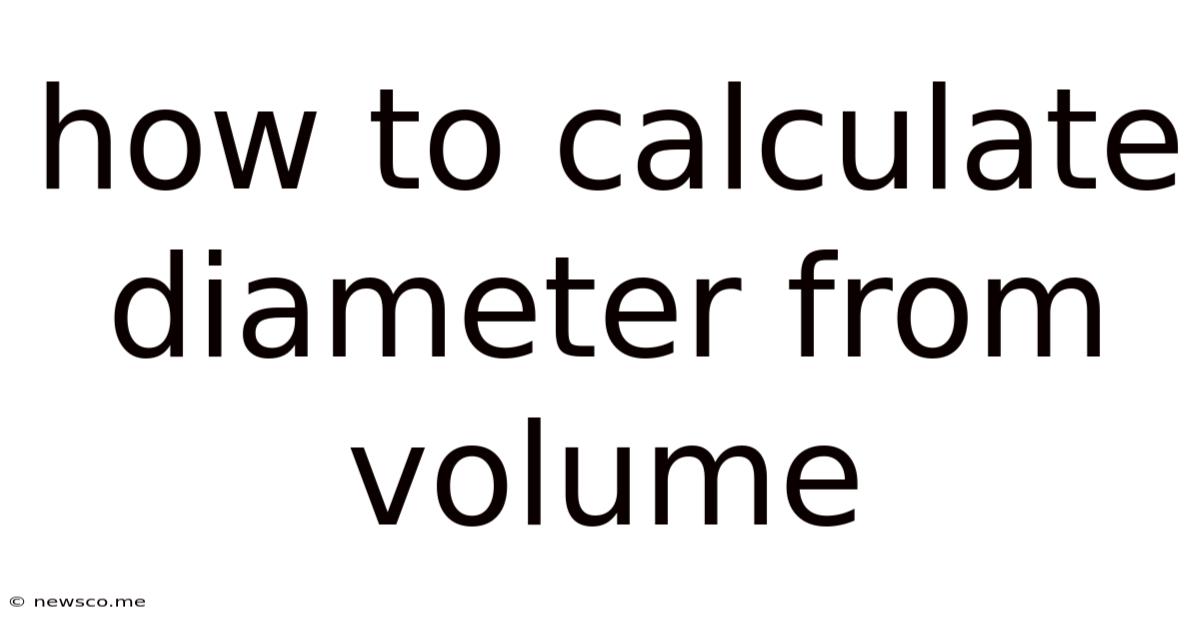How To Calculate Diameter From Volume
News Co
Mar 17, 2025 · 4 min read

Table of Contents
How to Calculate Diameter from Volume: A Comprehensive Guide
Calculating the diameter of a three-dimensional object knowing only its volume requires knowing the object's shape. The formula differs significantly depending on whether the object is a sphere, cylinder, cone, or another three-dimensional shape. This comprehensive guide will walk you through the process for several common shapes, providing clear explanations and example calculations. We'll also touch upon the implications of measurement errors and how to approach problems with more complex geometries.
Understanding the Relationship Between Diameter and Volume
The diameter is a linear measurement representing the distance across a circle or sphere passing through the center. Volume, on the other hand, measures the three-dimensional space occupied by an object. The crucial link between these two is the object's shape. The formula connecting volume and diameter inherently incorporates the geometrical properties of the shape. For instance, the volume of a sphere is directly proportional to the cube of its radius (and therefore related to the cube of its diameter), while the volume of a cylinder is proportional to the square of its radius (and therefore related to the square of its diameter) and its height.
Calculating Diameter from Volume: Common Shapes
Let's delve into the specific calculations for different shapes. Remember that accuracy depends heavily on accurate volume measurements.
1. Sphere
The sphere is perhaps the simplest case. Its volume (V) is given by the formula:
V = (4/3)πr³
where 'r' is the radius. Since the diameter (d) is twice the radius (d = 2r), we can rewrite the formula in terms of the diameter:
V = (π/6)d³
To find the diameter from the volume, we rearrange the formula:
d = ∛((6V)/π)
Example:
Let's say a sphere has a volume of 100 cubic centimeters. To find its diameter:
- Substitute the volume into the formula: d = ∛((6 * 100)/π)
- Calculate: d ≈ ∛(190.986) ≈ 5.76 cm
Therefore, the sphere's diameter is approximately 5.76 centimeters.
2. Cylinder
A cylinder's volume depends on both its diameter and its height (h). The formula is:
V = πr²h
Again, substituting d = 2r, we get:
V = (π/4)d²h
Solving for the diameter, we obtain:
d = √((4V)/(πh))
Example:
Consider a cylinder with a volume of 200 cubic centimeters and a height of 10 centimeters. To find its diameter:
- Substitute the values into the formula: d = √((4 * 200)/(π * 10))
- Calculate: d ≈ √(25.46) ≈ 5.05 cm
The cylinder's diameter is approximately 5.05 centimeters. Note how the diameter calculation depends on both the volume and the height.
3. Cone
The cone's volume formula is:
V = (1/3)πr²h
Substituting d = 2r:
V = (π/12)d²h
Solving for the diameter:
d = √((12V)/(πh))
Example:
A cone with a volume of 50 cubic centimeters and a height of 15 centimeters would have a diameter calculated as follows:
- Substitute values: d = √((12 * 50)/(π * 15))
- Calculate: d ≈ √(12.73) ≈ 3.57 cm
The cone's diameter is approximately 3.57 centimeters.
4. Cube
Calculating the diameter of a cube from its volume is straightforward. The volume of a cube is:
V = s³
Where 's' is the side length. The diameter (or more precisely, the diagonal across the cube) can be calculated using the Pythagorean theorem in three dimensions:
d = s√3
Since V = s³, we have s = ∛V. Therefore:
d = ∛V * √3
Example:
A cube with a volume of 64 cubic centimeters has a side length of ∛64 = 4 cm. Its diagonal (diameter) is:
d = 4√3 ≈ 6.93 cm
5. Other Shapes
Calculating the diameter from the volume for more complex shapes requires a more advanced understanding of calculus and potentially numerical methods. These often involve integrating over the shape's volume to arrive at a relationship between the volume and the relevant diameter or characteristic length. Consult relevant mathematical resources or software for these more challenging scenarios.
Handling Measurement Errors and Uncertainties
It's crucial to acknowledge that all measurements have inherent uncertainties. These uncertainties propagate through the calculations, influencing the accuracy of the calculated diameter. A small error in the volume measurement can lead to a relatively larger error in the calculated diameter, particularly when the diameter is raised to a power (as in the case of spheres and cones).
To account for uncertainties, consider using error propagation techniques. These techniques allow for calculating the uncertainty in the calculated diameter based on the uncertainty in the volume measurement. This involves partial derivatives and statistical analysis. Software packages like spreadsheet programs or dedicated mathematical software can simplify these calculations.
Conclusion: Precise Calculations Depend on Accurate Measurements and Shape Recognition
Calculating the diameter from the volume requires knowing the object's precise shape. The formulas presented here provide a starting point for various common shapes. However, always remember that the accuracy of your diameter calculation relies heavily on the precision of your volume measurement. Be mindful of measurement errors and, if necessary, use error propagation techniques to quantify the uncertainty in your final result. For more complex shapes, consult advanced mathematical resources or utilize specialized software for accurate calculations.
Latest Posts
Latest Posts
-
Find The Point On The Y Axis Which Is Equidistant From
May 09, 2025
-
Is 3 4 Bigger Than 7 8
May 09, 2025
-
Which Of These Is Not A Prime Number
May 09, 2025
-
What Is 30 Percent Off Of 80 Dollars
May 09, 2025
-
Are Alternate Exterior Angles Always Congruent
May 09, 2025
Related Post
Thank you for visiting our website which covers about How To Calculate Diameter From Volume . We hope the information provided has been useful to you. Feel free to contact us if you have any questions or need further assistance. See you next time and don't miss to bookmark.